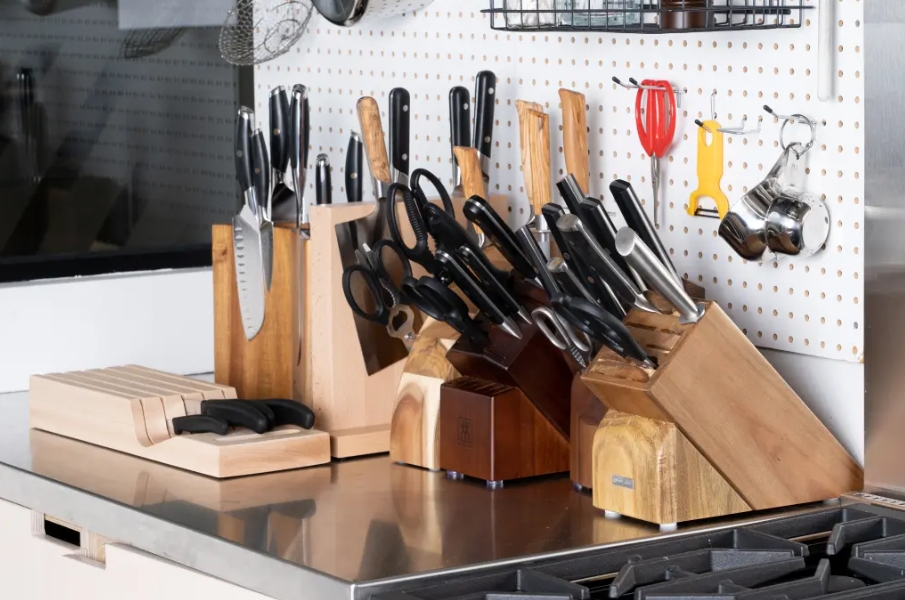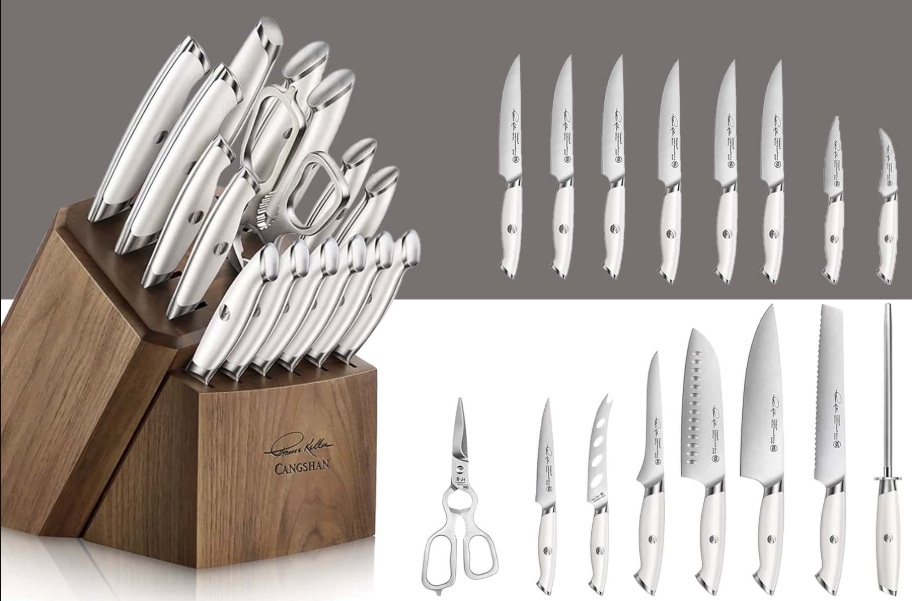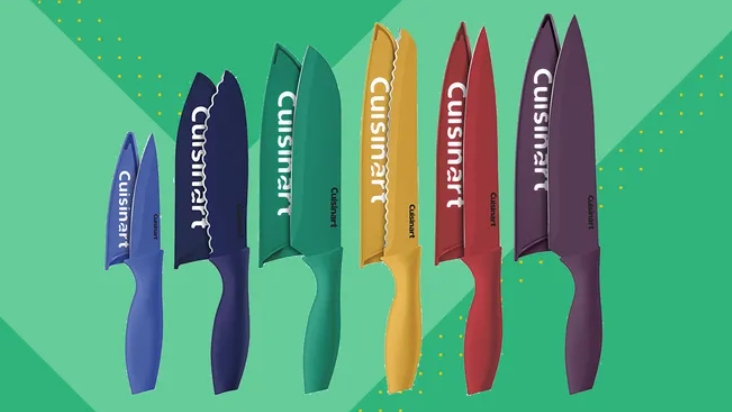

Views: 222 Author: Ella Publish Time: 2025-04-22 Origin: Site








Content Menu
● What Is a Kitchen (Chef's) Knife?
● Key Differences Between a Kitchen Knife and a Carving Knife
● When Should You Use Each Knife?
● How to Choose the Right Knife for Your Kitchen
● FAQ: Top 5 Questions About Kitchen and Carving Knives
>> 1. What makes a carving knife different from a chef's knife?
>> 2. Can a carving knife be used for vegetables?
>> 3. What is the ideal length for a carving knife?
>> 4. How should I maintain my carving and chef's knives?
>> 5. Do I really need both a chef's knife and a carving knife?
When it comes to essential kitchen tools, knives are at the top of the list. Yet, not all knives are created equal—each type serves a specific purpose, and understanding these differences can make a world of difference in your cooking. Among the most commonly confused are the kitchen (or chef's) knife and the carving knife. In this comprehensive guide, we'll explore the distinctions between these two knives, their unique features, best uses, and how to choose the right one for your culinary needs.

Knives are the backbone of any kitchen, but using the right knife for the right job is crucial for efficiency, safety, and the quality of your dishes. The chef's knife is often considered the workhorse of the kitchen, while the carving knife is a specialist tool that shines during large family meals and holiday feasts. Let's delve into the details that set them apart.
The kitchen knife, most commonly referred to as a chef's knife, is a versatile, all-purpose tool designed to handle a wide range of tasks. Its broad, slightly curved blade allows for a rocking motion, making it ideal for chopping, dicing, mincing, and slicing a variety of ingredients, from vegetables to meat[1][3][11].
Key Features:
- Blade Length: Typically 6–12 inches, with 8 inches being the most popular[3].
- Blade Shape: Broad and curved for rocking motions.
- Blade Width: Wider than a carving knife, providing stability.
- Tip: Sharp point, but broader than a carving knife's.
- Weight: Heavier and more balanced for power and control[11].
- Versatility: Suitable for most kitchen tasks, including chopping, slicing, dicing, and mincing.
A carving knife is a specialized tool designed primarily for slicing cooked meats, such as roasts, turkey, and ham. It features a long, thin blade that allows for precise, even slices with minimal resistance[2][3][9][10].
Key Features:
- Blade Length: Usually 8–14 inches, with 10 inches being common[3][8].
- Blade Shape: Long, narrow, and thin, often with a pointed or rounded tip[8][12].
- Blade Width: Much thinner than a chef's knife, reducing drag.
- Tip: Narrow and pronounced for maneuvering around bones[2][12].
- Weight: Lighter and more flexible for delicate carving[11].
- Specialization: Excels at slicing cooked meats into uniform pieces.
The distinctions between these knives aren't just cosmetic—they're rooted in their design and intended use.
| Feature | Kitchen (Chef's) Knife | Carving Knife |
|---|---|---|
| Blade Length | 6–12 inches (usually 8") | 8–14 inches (usually 10") |
| Blade Shape | Broad, curved, wide | Long, thin, narrow |
| Blade Thickness | Thicker, sturdier | Thinner, more flexible |
| Tip | Broad, sharp point | Narrow, pronounced point |
| Weight | Heavier, balanced | Lighter, more flexible |
| Best For | Chopping, dicing, mincing, slicing | Slicing cooked meats, roasts |
| Versatility | Highly versatile | Specialized |
| Cutting Motion | Rocking, chopping | Long, even slicing |

Use a Chef's Knife For:
- Chopping vegetables, fruits, and herbs
- Dicing onions, garlic, and shallots
- Slicing boneless meats and fish
- Mincing herbs and nuts
- General kitchen prep[1][3][11]
Use a Carving Knife For:
- Slicing cooked meats (roast beef, turkey, ham, chicken)
- Carving poultry and large roasts
- Creating thin, even slices for presentation
- Occasionally slicing large fruits (e.g., watermelon)[2][9][10][12]
Choosing between a chef's knife and a carving knife depends on your cooking habits:
- If you cook a wide variety of dishes: Invest in a high-quality chef's knife as your primary tool.
- If you frequently prepare large roasts or host dinners: Add a carving knife to your collection for perfect presentation and ease of slicing[2][10].
What to Look For:
- Blade Material: High-carbon stainless steel for durability and edge retention[8][12].
- Handle Comfort: Ergonomic handles for grip and control[11][12].
- Length: Choose a blade length that matches your typical tasks (longer for larger cuts of meat).
- Edge Type: Granton (scalloped) edges can reduce friction and prevent meat from sticking to the blade[3][12].
Proper care extends the life and performance of your knives.
Tips:
- Clean immediately after use with warm, soapy water; dry thoroughly.
- Store in a knife block, magnetic strip, or sheath to protect the blade[8].
- Sharpen regularly using a honing rod or whetstone[8].
- Avoid using carving knives on bones or frozen foods to prevent damage[9][10].
The difference between a kitchen (chef's) knife and a carving knife lies in their design, purpose, and performance. The chef's knife is the multitasker, essential for everyday prep work, while the carving knife is the specialist, designed for creating perfect slices of cooked meats. Both have their place in a well-equipped kitchen, and understanding when and how to use each will elevate your cooking and presentation.

A carving knife has a long, thin blade designed for slicing cooked meats into thin, even pieces. A chef's knife has a broader, heavier blade suited for a variety of kitchen tasks, including chopping, dicing, and mincing[2][3][9][11].
While a carving knife can be used to slice large fruits or vegetables, it is not recommended for general vegetable prep. The chef's knife is better suited for chopping and dicing vegetables due to its shape and weight[1][10][12].
Carving knives typically range from 8 to 14 inches, with 10 inches being the most popular size for home use[3][8][12].
Clean knives immediately after use, dry thoroughly, store safely, and sharpen regularly. Avoid using them on bones or frozen foods to prevent damage[8][11].
If you regularly prepare large roasts or host gatherings, a carving knife is worth the investment for presentation and ease. For everyday tasks, a chef's knife is indispensable[2][10][11].
[1] https://kamikoto.com/blogs/fundamentals/understanding-kitchen-knives-types
[2] https://madeincookware.com/blogs/why-you-need-a-carving-knife
[3] https://www.webstaurantstore.com/guide/538/types-of-knives.html
[4] https://www.istockphoto.com/photos/kitchen-knife
[5] https://www.istockphoto.com/photos/carving-knives
[6] https://www.youtube.com/watch?v=YrHpeEwk_-U
[7] https://www.youtube.com/watch?v=QX9FuLULaFI
[8] https://bladesjournal.com/faqs-carving-knife/
[9] https://chefsvisionknives.com/blogs/chefs-vision-blog/is-there-a-difference-between-a-carving-and-a-chef-knife
[10] https://www.thebambooguy.com/blogs/kitchen-knives/what-is-a-carving-knife-used-for
[11] /decoding-the-differences-between-a-chef-knife-and-a-carving-knife.html
[12] https://www.cutluxe.com/blogs/chef/slicing-knife-vs-carving-knife
[13] https://www.reddit.com/r/AskCulinary/comments/ssano/question_carving_knives_vs_chefs_knives/
[14] https://misen.com/blogs/news/types-of-kitchen-knives
[15] https://www.youtube.com/watch?v=QX9FuLULaFI
[16] https://www.carawayhome.com/blog/types-of-kitchen-knives
[17] https://zyliss.com/blogs/news/a-guide-to-the-different-types-of-kitchen-knives
[18] https://www.seriouseats.com/the-best-carving-and-slicing-knives-equipment
[19] https://www.escoffier.edu/blog/culinary-arts/different-knives-and-the-best-uses-for-each/
[20] https://www.everythingkitchens.com/knife-education-guide.html
[21] https://www.bladeforums.com/threads/chef-or-carver.323154/
[22] https://www.jessicagavin.com/types-of-kitchen-knives/
[23] https://www.seriouseats.com/the-best-essential-knives
[24] https://www.reddit.com/r/chefknives/comments/t7gakl/chef_vs_carving_knives/
[25] https://stock.adobe.com/search?k=chef+knife
[26] https://unsplash.com/s/photos/chef-knife
[27] https://www.istockphoto.com/photos/carving-knife
[28] https://www.youtube.com/watch?v=QgVyN6Lpiuc
[29] https://www.youtube.com/watch?v=lQVJO_WxFXo
[30] https://www.youtube.com/watch?v=007Epg1ztns
[31] https://www.wusthof.com/collections/all-purpose-knives/chefs-knives
[32] https://www.flexcut.com/home/category/wood-carving-knives
[33] https://www.youtube.com/watch?v=-al-bs737fw
[34] https://www.youtube.com/watch?v=eB45kteiRtU
[35] https://www.youtube.com/watch?v=nV_ET-TEMjE
[36] https://www.freepik.com/free-photos-vectors/chef-knife
[37] https://www.youtube.com/watch?v=GjHaMLsHUUQ
[38] https://madeincookware.com/blogs/types-of-kitchen-knives
[39] /chef-knife-vs-carving-knife-which-is-better-for-slicing-meat.html
[40] https://www.blackmoorhome.co.uk/blog/a-guide-to-different-types-of-kitchen-knives/
[41] https://www.kuvings.com.au/the-complete-guide-to-knives/
[42] https://www.divertimenti.co.uk/blogs/the-cookery-edit/common-knife-questions
[43] https://www.bladeforums.com/threads/butchering-knives-vs-chefs-knives.1751723/
[44] https://www.performancefoodservice.com/get-inspired/a-guide-to-kitchen-knives
[45] https://www.knivesandtools.com/en/ct/buying-guide-what-do-you-want-to-cut-kitchen-knives.htm
[46] https://elementknife.com/pages/common-questions-about-kitchen-knives
[47] https://www.reddit.com/r/chefknives/comments/8te7z1/first_real_chefs_knife_any_advice_for_how_to_take/
[48] https://www.istockphoto.com/illustrations/chef-knife
[49] https://www.benchmade.com/collections/cutlery
[50] https://www.youtube.com/watch?v=SebBF2g6XtI
[51] https://www.vecteezy.com/free-vector/kitchen-knife
[52] https://www.knivesandtools.com/en/ct/buying-guide-carving-knives.htm
[53] https://www.thebambooguy.com/blogs/kitchen-knives/frequently-asked-questions-about-kitchen-knives
[54] https://www.youtube.com/watch?v=5mv39YDvjqI